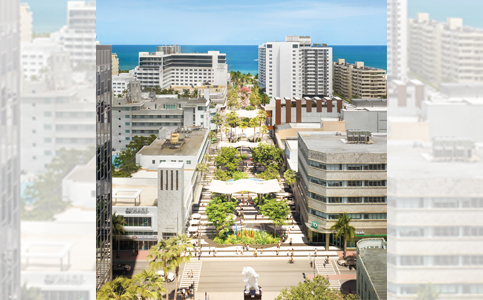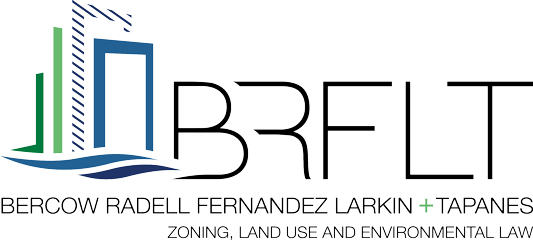CLIENT NEWS: Public-private team speeds Lincoln Road east end renewal
September 26, 2025Improvements to Miami Beach Lincoln Road’s 100, 200 and 300 blocks are nearer on the horizon as a private-public partnership has just concluded an agreement on how money will be spent and the long-term project will be executed with a pedestrian focus.
Peter Kanavos, executive vice president of development for Flag Luxury, a partner of Sobe Sky Development, shared with Miami Today how plans to improve Lincoln Road’s 100, 200 and 300 blocks are progressing.
“A couple years back,” said Mr. Kanavos, “Commissioner [Alex] Fernandez and I came to an understanding of the fact that Lincoln Road … – especially east end Lincoln Road – was in dire need of revitalization, and we worked out a program. We got funding from the state to match city and private funds, and we just, in the last month, completed an agreement on how those monies will be spent – in other words, how the project will be executed.
“It took quite a while,” he said. “There were a lot of players and … lenders, and many people in the city staff and my partners and everything. But we finally got that done, so that’s been put to bed. We now have to address some issues on the 200 and 300 block.”
Mr. Fernandez highlighted the impact the plans are geared to have on the city.
“This is the unwrapping of a renaissance,” said Mr. Fernandez. “The city and the Ritz Sagamore team came together in this public-private partnership. The city understood that if we wanted to seriously address the ailments that are plaguing the east end of Lincoln Road, it just wouldn’t be government by itself. The most successful approach would be entering into this public-private partnership where we are completely reimagining this 100 block, giving it an entrance to the beach worthy of the location it’s at.”
This is the main pedestrian promenade that enters the city’s seven miles of beach walk. However, today, the area feels blighted.
Mr. Fernandez said the plan to enter into this public private partnership is one of the first initiatives he pursued even before being elected. This is a partnership in which “the developer would leverage funds, the city would leverage dollars, and the state would leverage dollars to reimagine this block, and $4 million investment that the city is making – the taxpayers – is getting $12 million worth of improvements in this area. And then we’re going to see the spillover effect into the 200 and 300 blocks, where Miami-Dade County has already looked at a traffic study and given us comments, so that we can hopefully move forward with a pedestrianization of the 200 and 300 blocks.”
This means, said Mr. Fernandez, the city will be able to move the bus stop at Lincoln Road and continue the energy of pedestrian activity past Washington Avenue and all the way to Collins Avenue.
The initiative will help businesses improve the quality of retail that’s available by giving them space to expand into the sidewalk, said Mr. Fernandez. Additionally, it’s part of a bigger vision and a master plan to bring housing into this area to sustain the economy of the businesses of this part of Lincoln Road.
Mr. Fernandez said stores currently in this area are those such as 7-Eleven that don’t “contribute to the economy of Lincoln Road. We want quality retail there, but for that quality retail to succeed, we need permanent full-time residents that are going to sustain that retail activity. So not only are we looking at this tremendous public-private partnership, but we’re looking at our zoning to create opportunities for housing for full-time residents that will support and sustain the economy of Lincoln Road.”
As part of the agreement signed with the city, said Mr. Kanavos, they took on several obligations to help facilitate the revitalization of the 200 and 300 blocks. A milestone that was recently achieved is working with the county for a year and being able to secure – with the traffic study – the permission to relocate the buses.
“This has been tried many, many times before,” said Mr. Kanavos, “but we finally succeeded and to close off the road for pedestrianization. The next step for that would be a resolution by the commission at a date to be determined in the near future for the actual road closure.
“But one of the other commitments that we made was to cover the soft cost to provide a plan for the closure of the road,” he said. “We did submit a conceptual plan. I think it’s probably in need of working out some more detail on it for something that really makes sense, and we’d like to get some consensus buy-in from the property owners on that.”
However, there’s much more to complete, he said. The 200 and 300 blocks are the “more difficult part of the equation, but nothing set in stone yet. We’re working with the city to try and come up with the best vision possible that works. And that would engage the property owners that would justify spending the dollars on revitalizing the 200 and 300 blocks.
“But I think the main thing is,” said Mr. Kanavos, “we’ve got the platform now. We’ve got the precondition – most important precondition – accomplished with Dade County, and then now the ball is in our court to go ahead and further this project along.”
Mr. Fernandez said pedestrianization can come in phases, and they can begin “in the short term with immediate solutions, as simple as putting the proper barriers to stop traffic and expanding into the roadway. That’s what we’re studying now, looking at that traffic study from Miami-Dade County, the conditions they put in place…. The next steps could, quite frankly, be very short term, while we work on the long-term funding for the bigger plan.”
Mr. Kanavos said plans for the 100 block have been broken into components. Life safety issues are paramount. Much of what has been done aims to ameliorate life safety concerns. Additionally, the idea of installing an art walk along both sides of the road is being discussed. There are also plans to install a monument for the entrance to the beach path, “which would be a sort of completion of [hotels architect] Morris Lapidus’ vision; could be an arch, or something similar to an archway. And we have a little park at the end of the entrance to the beach… where it joins the city boardwalk. There’s a little kind of mini-oasis park there. And along the entrance, too, we’re planning on putting some artwork.”
One challenge the area has, said Mr. Fernandez, is it’s unwelcoming and doesn’t feel safe. This attracts ailments to this area. “That’s why I’m so excited that we’re going to be completely redesigning this block, literally from the ground up. The pedestrian walkway will be reconfigured. There’s a new green space that will mark the transition to our seven miles of beach walk, which is really quite incredible.”
The east end of Lincoln Road is not only the gateway to the seven-mile stretch of beach walk, said Mr. Kanavos, but it’s also the gateway to the rest of Lincoln Road.
“It’s a key area,” he said. “It was once, probably the most iconic part of the city. When I say once, it’s kind of fallen into a state of disrepair, but if we’re able to complete the vision we’re talking about on these three blocks, what we’ve accomplished is the true vision of [fabled Miami Beach developer] Carl Fisher, which was a green belt thoroughfare from bay to sea.”
There’s still work to be done, said Mr. Kanavos.
“We have challenges,” he said. “There’s other things out there looming on the horizon, Live Local [state housing use bonuses] and things like that, which we have to account for, which complicates some situations, but I’m confident that if we just keep an open and honest dialog between the development community and the city, hopefully we can come up with some mutual solutions, and this was one example of getting that ball rolling.”




















































